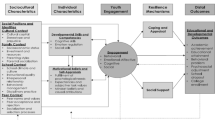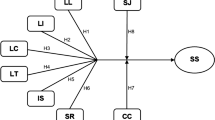Abstract
One of the most pressing issues in online learning systems that have contributed to the failure of online education and student dropout is the lack of interaction. Investigating and exploring the different factors that influence learners’ online interaction and engagement are crucial for e-learning success. This study proposes a research model to assess the possible impact of the student’s personal attributes and perceived course characteristics on their online interaction and engagement. The data of this study were collected by survey from 246 students who participated in online courses in one of Australia universities. Partial least squares was then used as a method to test the research model and hypotheses.







Similar content being viewed by others
References
Ajzen, I., & Fishbein, M. (1988). Theory of reasoned action-theory of planned behavior. Tampa, FL: University of South Florida.
Bagozzi, R. P., & Yi, Y. (1988). On the evaluation of structural equation models. Journal of the Academy of Marketing Science, 16(1), 74–94.
Bandura, A. (1977). Self-efficacy: Toward a unifying theory of behavioral change. Psychological Review, 84(2), 191.
Bandura, A. (1986). Social foundations of thought and action: A social cognitive theory. Englewood Cliffs NJ: Prentice-Hall Inc.
Banna, J., Lin, M.-F. G., Stewart, M., & Fialkowski, M. K. (2015). Interaction matters: Strategies to promote engaged learning in an online introductory nutrition course. Journal of Online Learning and Teaching/MERLOT, 11(2), 249.
Barnard, L., Lan, W. Y., To, Y. M., Paton, V. O., & Lai, S.-L. (2009). Measuring self-regulation in online and blended learning environments. The Internet and Higher Education, 12(1), 1–6.
Beatty, B. J. (2002). Social interaction in online learning: A situationalities framework for choosing instructional methods. Faculty of the University Graduate School as partial fulfillment of the requirements for the degree Doctor of Philosophy in the Department of Instructional Systems Technology, Indiana University.
Bing, W., & Ping, T. A. (2008). A comparative analysis of learners interaction in the online learning management systems: Does national culture matter? AAOU Journal, 3(1), 1–16.
Brooks, A. K., Resta, P. E., & Schmidt, K. J. (2004). Students’ attitudes toward interaction in online learning: Exploring the relationship between attitudes, learning styles, and course satisfaction.
Bulu, S. T. (2012). Place presence, social presence, co-presence, and satisfaction in virtual worlds. Computers & Education, 58(1), 154–161.
Chen, Y.-J., & Chen, P.-C. (2007). Effects of online interaction on adult students’ satisfaction and learning. The Journal of Human Resource and Adult Learning, 3(2), 78–89.
Chin, W. W. (1998). Commentary: Issues and opinion on structural equation modeling: JSTOR.
Chin, W. W. (1998). The partial least squares approach to structural equation modeling. Modern Methods for Business Research, 295(2), 295–336.
Daradoumis, T., Xhafa, F., & Marques, J. M. (2003). Exploring interaction behaviour and performance of online collaborative learning teams. In: Groupware: Design, implementation, and use (pp. 126–134): Springer, New York.
Davis, F. D. (1989). Perceived usefulness, perceived ease of use, and user acceptance of information technology. MIS Quarterly, 13, 319–340.
Eikebrokk, T. R., & Olsen, D. H. (2007). An empirical investigation of competency factors affecting e-business success in European SMEs. Information & Management, 44(4), 364–383.
Eom, S. (2019). The effects of student motivation and self-regulated learning strategies on student’s perceived e-learning outcomes and satisfaction. Journal of Higher Education Theory and Practice, 19(7), 29–42.
Fabrigar, L. R., Wegener, D. T., MacCallum, R. C., & Strahan, E. J. (1999). Evaluating the use of exploratory factor analysis in psychological research. Psychological Methods, 4(3), 272.
Farahani, G. O. (2003). Existence and importance of online interaction. Dissertation, Virginia Tech.
Farahani, G. O. (2003). Existence and importance of online interaction. Doctoral dissertation, Virginia Tech.
Fornell, C., & Larcker, D. F. (1981). Evaluating structural equation models with unobservable variables and measurement error. Journal of Marketing Research, 18, 39–50.
Gefen, D., Straub, D., & Boudreau, M.-C. (2000). Structural equation modeling and regression: Guidelines for research practice. Communications of the Association for Information Systems, 4(1), 7.
Hair, J. F., Ringle, C. M., & Sarstedt, M. (2011). PLS-SEM: Indeed a silver bullet. Journal of Marketing Theory and Practice, 19(2), 139–152.
Hao, Y. (2006). Investigate the relationships of student attitudes toward interaction, learning styles, and their online learning readiness in higher education. Paper presented at the World Conference on E-Learning in Corporate, Government, Healthcare, and Higher Education.
Heinemann, M. H. (2007). Teacher−student interaction and learning in online theological education. Part four: Findings and conclusions. Christian Higher Education, 6(3), 185–206.
Hulland, J., & Business, R. I. S. O. (1999). Use of partial least squares (PLS) in strategic management research: A review of four recent studies. Strategic Management Journal, 20(2), 195–204.
Kang, M., & Im, T. (2013). Factors of learner–instructor interaction which predict perceived learning outcomes in online learning environment. Journal of Computer Assisted Learning, 29(3), 292–301.
Kaymak, Z. D., & Horzum, M. B. (2013). Relationship between online learning readiness and structure and interaction of online learning students. Educational Sciences Theory and Practice, 13(3), 1792–1797.
Ke, F., & Kwak, D. (2013). Online learning across ethnicity and age: A study on learning interaction participation, perception, and learning satisfaction. Computers & Education, 61, 43–51.
Kuo, F., Tseng, F., Lin, C. I., & Tang, W. (2013). Critical success factors for motivating and sustaining women's ICT learning. Computers & Education, 67, 208–218.
Kuo, Y., Walker, A., & Schroder, K. (2010). Interaction and other variables as predictors of student satisfaction in online learning environments. Paper presented at the Society for Information Technology & Teacher Education International Conference.
Kuo, Y., Walker, A. E., Belland, B. R., Schroder, K. E., & Kuo, Y.-T. (2014). A case study of integrating Interwise: Interaction, internet self-efficacy, and satisfaction in synchronous online learning environments. The International Review of Research in Open and Distributed Learning.
Kyei-Blankson, L., Ntuli, E., & Donnelly, H. (2016). Establishing the importance of interaction and presence to student learning in online environments. World Journal of Educational Research, 3(1), 48.
Lear, J. L., Ansorge, C., & Steckelberg, A. (2010). Interactivity/community process model for the online education environment. Journal of Online Learning and Teaching, 6(1), 71–77.
Matell, M. S., & Jacoby, J. (1971). Is there an optimal number of alternatives for Likert scale items? I. Reliability and validity. Educational and Psychological Measurement, 31, 657–675.
McGhee, R. M. H. (2010). Asynchronous Interaction, Online Technologies Self-Efficacy and Self-Regulated Learning as Predictors of Academic Achievement in an Online Class. ProQuest LLC.
Moon, J., Li, J., Jo, S., & Sanders, G. (2006). Improving quality of life via blogs and development of a virtual social identity. Journal of Information Technology Management, 17(3), 26–37.
Moore, M. G. (1989). Editorial: Three types of interaction.
Morreale, S., Staley, C., Stavrositu, C., & Krakowiak, M. (2015). First-year college students' attitudes toward communication technologies and their perceptions of communication competence in the 21st century. Communication Education, 64(1), 107–131.
Mosholder, R. S. (2007). Evaluating engagement with, and determining the direct effects of, a curriculum teaching students learning and motivation strategies. The Ohio State University.
Okonta, O. (2010). Effects of online interaction via computer-mediated communication (CMC) tools on an e-mathematics learning outcome. ProQuest LLC.
Perotti, V. S., & DeWine, S. (1987). Competence in communication: An examination of three instruments. Management Communication Quarterly, 1(2), 272–287.
Rhema, A., & Miliszewska, I. (2014). Analysis of student attitudes towards e-learning: The case of engineering students in Libya. Issues in Informing Science and Information Technology, 11(1), 169–190.
Richardson, J., & Swan, K. (2003). Examing social presence in online courses in relation to students' perceived learning and satisfaction. Journal of Asynchronous Learning Network. https://doi.org/10.24059/olj.v7i1.1864
Richardson, J., Tunwall, C., & Carnevale, C. (2000). The affordances and constraints of asynchronous learning networks: Looking at interaction in an online environment. Paper presented at the world conference on educational multimedia, hypermedia and telecommunications.
Sallnäs, E.-L., Rassmus-Gröhn, K., & Sjöström, C. (2000). Supporting presence in collaborative environments by haptic force feedback. ACM Transactions on Computer-Human Interaction (TOCHI), 7(4), 461–476.
Schunk, D. H. (1989). Social cognitive theory and self-regulated learning. In B. J. Zimmerman & D. H. Schunk (Eds.), Self-regulated learning and academic achievement (pp. 83–110). Berlin: Springer.
Short, J. A., Williams, E., & Christie, B. (1976). The social psychology of telecommunications. New York: Wiley.
Siemens, G. (2014). Connectivism: A learning theory for the digital age.
Spears, L. R. (2012). Social presence, social interaction, collaborative learning, and satisfaction in online and face-to-face courses.
Spitzberg, B., & Cupach, W. (2012). Handbook of interpersonal competence research. Berlin: Springer Science & Business Media.
Tajfel, H., & Turner, J. C. (1979). An integrative theory of intergroup conflict. The Social Psychology of Intergroup Relations, 33(47), 74.
Tatar, D., Gray, J., & Fusco, J. (2002). Rich social interaction in a synchronous online community for learning. Paper presented at the proceedings of the conference on computer support for collaborative learning: Foundations for a CSCL community.
Watson, S. (2010). Increasing online interaction in a distance education MBA: Exploring students' attitudes towards change. Australasian Journal of Educational Technology, 26(1), 63–84.
Wilson, J. (2007). An examination of the relationships of interaction, learner styles, and course content on student satisfaction and outcomes in online learning. University of Southern Queensland.
Wong, K. K.-K. (2013). Partial least squares structural equation modeling (PLS-SEM) techniques using SmartPLS. Marketing Bulletin, 24(1), 1–32.
Yoo, S., Jeong Kim, H., & Young Kwon, S. (2014). Between ideal and reality: A different view on online-learning interaction in a cross-national context. Journal for Multicultural Education, 8(1), 13–30.
Zimmerman, B., & Schunk, D. (2001). Theories of self-regulated learning and academic achievement: an overview and analysis. In B. J. Zimmerman & D. H. Schunk (Eds.), Self-regulated learning and academic achievement (pp. 1–37). NJ: Mahwah.
Zimmerman, B. J. (1989). Models of self-regulated learning and academic achievement. In B. J. Zimmerman & D. H. Schunk (Eds.), Self-regulated learning and academic achievement (pp. 1–25). New York: Springer.
Author information
Authors and Affiliations
Corresponding author
Ethics declarations
Conflicts of interest
The first author, Afrooz Purarjomandlangrudi, was doing this research as a part of her PhD degree in Griffith University, but she finalises the manuscript just recently when she is working in Holmes Institute.
Ethical approval
“All procedures performed in studies involving human participants were in accordance with the ethical standards of the institutional and/or national research committee (GRIFFITH UNIVERSITY HUMAN RESEARCH ETHICS REVIEW, GU Ref No: 2015/755) and with the 1964 Helsinki declaration and its later amendments or comparable ethical standards.”
Informed consent
Informed consent was obtained from all individual participants included in the study.
Additional information
Publisher's Note
Springer Nature remains neutral with regard to jurisdictional claims in published maps and institutional affiliations.
Rights and permissions
About this article
Cite this article
Purarjomandlangrudi, A., Chen, D. Exploring the influence of learners’ personal traits and perceived course characteristics on online interaction and engagement. Education Tech Research Dev 68, 2635–2657 (2020). https://doi.org/10.1007/s11423-020-09792-3
Published:
Issue Date:
DOI: https://doi.org/10.1007/s11423-020-09792-3




